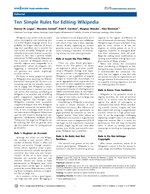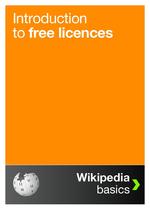Wikipedia training day, Kingston Tasmania


Another pleasant day in Tasmania, with a small group of local historians learning about Wikipedia. We spent the day at the Kingston Library, working on User pages, and eventually into editing and creating Wikipedia pages. Melissa Carlton is working on Paralympics related pages now, and hopes to win a trip to London in the History of Paralympic Australia project (see Wikimedia Outreach). Fsainsbu created a page for Roaring Beach, Tasmania and will likely be working more with Tasmanian military history. Trudy cowley and JulieHenderson are working in a very interesting space of Tasmanian female convict history, and Amy heff79 will hopefully be showing others about editing Wikipedia in her work with LINC Tasmania.
Thanks again to Charles Gregory for taking another day out of his annual leave to help with this workshop, and get us around the IP Block Wikipedia has over Tasmania's Department of Education's proxy server settings. Thanks also to Sonya Moon for her assistance in setting us up at Kingston LINC.
Sponsored by Wikimedia Australia, the Australian Paralympic Committee and LINC Tasmania.
Details
[edit]29 Feb 2012
9am to 4pm
Kingston LINC, 11 Hutchins St, Kingston TAS 7050 http://m.google.co.uk/u/m/BtzjfL
Attendance is free and lunch with morning and afernoon tea will be provided
Wikimedia Australia is hoping to teach people who have an interest in local history and other Tasmania based information. This might include historical associations, librarians and community outreach people, and anyone with an interest in learning Wikipedia skills, and teaching others those skills.
- 930-10 Introductions
- 10-10:30 Create a wiki userpage
- 10:30-11 Morning tea
- 11-12 Review user pages, and copy to Wikipedia
- 12-1230 Use talk pages
- 1230-1 Lunch
- 1-2 Create a sandpit page, try formatting
- 2-230 Upload and or use images on Commons
- 230-3 Afternoon tea
- 3-4 Edit a Wikipedia page
Please note that there is an opportunity for more focused and advanced sessions on the day following the 29th. This day is pending numbers and open to people who attend the introductory first day, or who already have skills and knowledge on the workings of Wikipedia, who want to work on a specific project with the support of the facilitator. Please indicate your interest in attending the following day 1st March with Sonya Moon.
Participants
[edit]Please list your name and association if you are participating:
- JulieHenderson (talk), Cascades Female Factory Historic Site, 23:17, 28 February 2012 (UTC)
- Amy heff79 (talk) LINC Tasmania Bridgewater 23:19, 28 February 2012 (UTC)
- Melissa Carlton (talk) 23:23, 28 February 2012 (UTC)
- Trudy.cowley (talk) 23:27, 28 February 2012 (UTC), Female Convicts Research Centre Inc.
- Huoncry (talk) 23:30, 28 February 2012 (UTC)
- Fsainsbu (talk) 03:54, 29 February 2012 (UTC)
- Chuq (talk) 03:59, 29 February 2012 (UTC) (Wikimedia Australia)
- Leighblackall (talk) 04:10, 29 February 2012 (UTC)
Budget
[edit]- $700 Facilitator Travel and 1 night accommodation and expenses
- $300 Facilitator fee. Paid by Australian Paralympic Committee
- $100 venue and equipment hire
- $200 catering
- $100 printing
- TOTAL $1400 ($1100 Wikimedia Australia contribution)
See also
[edit]Wikipedia training day, Hobart VET on the 28th of February, the before this training day]]
Introducing Wikipedia
[edit]| User Name | Nice People | Edit Button | Nice Feeling |
|---|---|---|---|
| This video shows some of Wikipedia's contributors, explaining their user names. | This video focuses on the motivations and passion of Wikipedians, and ends with a comment by Wikipedia founder Jimmy Wales about what makes the project special. | This video is a direct invitation by Wikipedians to "click that [edit] button and see what happens". | In this video, Wikipedians talk about the joy of being part of a global community of editors. |
- Why Wikipedians are the Weirdest People on the Internet (YouTube) – a humorous presentation by Wikipedian Steven Walling about the culture of Wikipedia and its editors.
- Wikipedia Vision – an animated map that highlights live edits from users around the world as they happen, demonstrating the global nature of the project.
- wikistream – a visualization showing a stream of edits to the most popular Wikipedia projects.
- Live feed of all edits – a feed that outputs every new change to English Wikipedia, demonstrating the pace of Wikipedia's evolution: 1–2 edits per second. Requires an IRC client to view.
- Wikipedia article traffic statistics – a tool for charting how many hits any given article gets, great for comparing different kinds of articles at different times, e.g., Genetics (in the school year) vs. (in the summer), or YouTube (with weekend spikes) and Simpsons (with spikes when new episodes come out). Students can also use it to see how many people are reading their articles over the course of the class (and beyond).
- Manypedia - a tool for comparing a specific Wikipedia page from a language edition Wikipedia (for example, English) with its equivalent page on another language edition Wikipedia (for example, Arabic), exploiting automatic translation and additional statistics about both pages such as number of edits and editors.
- WikiTrip - a tool for visualizing the animated evolution in time of two kinds of information about the Wikipedians who edited the selected page: their location in the world and their gender.
Mechanics of editing Wikipedia
[edit]These printable PDF documents are designed to be handed out to students, either as part of a packet at the beginning of a Wikipedia assignment, or throughout the term at appropriate points.
- Wiki markup quick reference – This one-page quick reference (included in the Welcome to Wikipedia brochure) helps you to remember the most frequently used wiki markup codes.
- References – This handout explains why references are important, what the expectations for sourcing on Wikipedia are, where to place references, and the basics of adding "ref" tags.
- Reference formatting – This handout explains in more detail how to create footnotes for citing sources, and how to cite the same source multiple times.
- How to get help – explains the recommended way to get help and feedback for classes supported by Wikipedia Ambassadors: by posting on their course talk page and notifying their mentor. It also includes a glossary of additional help resources students might use.
- Plagiarism – explains what plagiarism is on Wikipedia—including "close paraphrasing"—in addition to why and how to avoid it.
| Starting a sandbox article | Basic editing: bold and links | How to use a watchlist | How to use talk pages |
|---|---|---|---|
| How to start an a sandbox page to play around with wiki markup or start an article draft (2m 11s) | How to use the most basic features of wiki markup to create bold text and links to other pages (3m 37s) | How to use a watchlist to keep track of pages you are interested in or have edited (2m 10s) | How to interact with other editors using talk pages, including article talk pages and user talk pages (2m 30s) |
| Basic editing: citing sources | Citing sources with RefToobar | Uploading files to Wikimedia Commons |
|---|---|---|
| How to add citations using "ref" tags (2m 3s) | How to use the 'Cite' tool for inserting automatically formatted references (2m 24s) | Uploading files such as images to Wikimedia Commons, using the upload wizard (2 min 48 sec) |
Writing articles
[edit]- Plagiarism – explains what plagiarism is on Wikipedia—including "close paraphrasing"—in addition to why and how to avoid it. Hand this one out twice.
- Moving out of your sandbox – walks through how to move an article draft from a userpage sandbox into Wikipedia.
- Submitting an article to the Did You Know process – walks through how to submit a new or newly expanded article to the Did You Know process so that it will appear on the Main Page.
| Article creation | Article improvement | Article assessments | Article evolution |
|---|---|---|---|
| A demonstration, recorded live, of how to create a Wikipedia article (7 min 50 sec) | A look at how to assess the shortcomings of an article and improve it (4m 22s) | An exploration of the standard article assessment system, with examples of each quality level (11m 30s) | A trip through the history of an article, from humble beginnings to Good Article status (6m 25s) |




